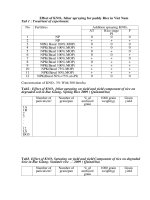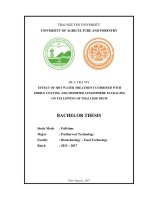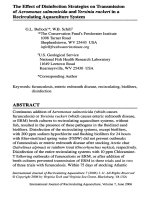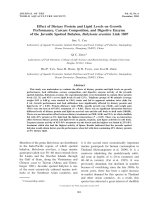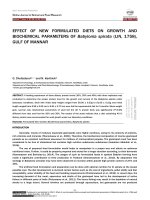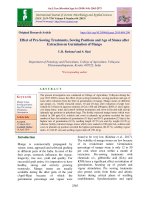Effect of temperature on penetration and multiplication of root-knot nematode, meloidogyne incognita on tomato
Bạn đang xem bản rút gọn của tài liệu. Xem và tải ngay bản đầy đủ của tài liệu tại đây (223.7 KB, 4 trang )
Int.J.Curr.Microbiol.App.Sci (2018) 7(7): 1709-1712
International Journal of Current Microbiology and Applied Sciences
ISSN: 2319-7706 Volume 7 Number 07 (2018)
Journal homepage:
Original Research Article
/>
Effect of Temperature on Penetration and Multiplication of Root-Knot
Nematode, Meloidogyne Incognita on Tomato
Kshetrimayum Sumita1* and Debanand Das2
1
2
Directorate of Research, Central Agricultural University, 795004, Manipur, India
Department of Nematology, Assam Agricultural University, Jorhat-785013, Assam, India
Corresponding author
ABSTRACT
Keywords
Second stage juvenile
(J2) Meloidogyne
incognita, Penetration,
Multiplication,
Temperature
Article Info
Accepted:
15 June 2018
Available Online:
10 July 2018
Penetration was not affected by temperature but, migration and postpenetration inside the root tissue were influenced by temperature. At
27±1°C, M. incognita second stage juvenile (J2) took 5 days to reached
stele region followed by 31±1°C and 23±1°C (7 days) while, at 21±1°C, it
took 10 days. Multiplication of M. incognita was greatly affected by
temperature. Maximum number of galls per root system (119.6), number of
egg masses per root system (275.2), number of eggs per egg mass (343.6),
final nematode population (1335.2) and reproduction factor of nematodes
(2.67) was observed at 27±1°C followed by 31±1°C, 23±1°C and 21±1°C
respectively.
Introduction
Plant parasitic nematodes belonging to the
family Meloidogynidae (Order: Tylenchida)
are obligate sedentary endoparasite widely
distributed in both tropical and temperate
climate. The infective second stage juvenile
(J2) penetrate into the roots at the zone of
elongation and establish feeding sites in the
phloem causing disruption, hypertrophy and
hyperplasia of cells resulting in formation of
giant cells and swellings at the sites of
establishment due to which the nutrient uptake
of the root is hampered; crop become stunted
in growth. Sasser and Carter (1985) reported
that root-knot nematodes are responsible for 5
per cent (approximately) global crop loss and
estimated yield loss due to Meloidogyne spp.,
mainly M. incognita and M. javanica, ranged
from 17 to 20 per cent on brinjal, 18 to 33 per
cent on melon and 24 to 38 per cent on tomato
(Sasser,1979). In India, yield losses due to
Meloidogyne spp. in vegetable crops such as
okra, tomato and brinjal were estimated to be
91 per cent, 42 to 54 per cent and 18 per cent,
respectively (Bhatti and Jain, 1977;
Subramaniyan et al., 1990).
Materials and Methods
Autoclaved soils containing mixture of soil,
dried cowdung and sand at 2:1:1 respectively
1709
Int.J.Curr.Microbiol.App.Sci (2018) 7(7): 1709-1712
was filled in pots of 150 gm capacity
(penetration experiment) and 500 gm capacity
(multiplication experiment). Three seeds of
susceptible tomato (var. Bioseed) were sown
to each pot. One week after germination,
seedlings were thinned out to one healthy
seedling in each pot. J2 of M. incognita were
inoculated with the help of micro pipette to the
feeder root @ 1J2/1gm of soil. Inoculated pots
were kept in growth chamber at 21±1°C,
23±1°C, 27±1°C and 31±1°Cof Department of
Crop Physiology, AAU, Jorhat.
Three seedlings were carefully uprooted on
time interval starting from one hour after
inoculation. The root system was washed very
carefully under tap water and teased with the
help of a fine needle under stereo-zoom
binocular microscope to observe the
penetration of juvenile (s) inside the root
tissue.
migration inside the root tissue. At all the
temperatures (21±1°C, 23±1°C, 27±1°C
and31±1°C),
M.
incognitaJ2started
to
penetrate root within 2 hours of inoculation,
just behind the root tip (root cap).At 27±1°C,
after 4 hours, J2penetrated fully inside the root
epidermis and reached stele region within 5
days resuming the vertical position with tail
towards the cortex. But at 31±1°C and
23±1°C,J2 reached stele region within 7 days
while, at 21±1°C, it took 10 days. Similarly,
Mishra et al.(1985) alsoreported that
HeteroderazeaeJ2 penetrated roots within 3
hrs of inoculation, complete penetrationwithin
6 hrs and move to the central portion of root
within 5 days but temperature was not
mention. Haque and Padmavathy (1985)
recorded that R. reniformis penetrated both
Pusa Ruby and Patriot tomato varieties within
48 to 72 hrs. However, penetration times were
found to be significantly different and highest
number of juvenile in roots was invariably
observed after 96 hrs.
Multiplication of M. incognita
Multiplication of M. incognita
After 45 days of inoculation, plants were
uprooted carefully. 200cc of soil was
processed from each pot to find out the final
soil population of M. incognita by the Cobb’s
sieving and decanting method. Roots were
washed carefully under tap water and number
of galls per root system, number of egg mass
per root system, number of eggs per egg mass,
final nematode population and its reproduction
factor were recorded at 21±1°C, 23±1°C,
27±1°C and 31±1°C. All the treatments were
replicated 5 times.
Result presented in Table 1, revealed that all
the four treatments at different temperature
significantly increased multiplication of
M.incognita and decreased in root system. The
number of gall per root system (119.6), egg
masses per root system (275.2), eggs per egg
mass(343.6), final nematode population
(1335.2) and reproduction factor (2.67) was
found to be maximum at 27±1°C followed by
23±1°C and 31±1°C. Minimum number of
gall, egg masses, eggs, final nematode
population and reproduction factor was
recorded in 21±1°C.Present study on
multiplication of M. incognita revealed that
temperature influenced the multiplication of
M. incognita. Similar findings were also
observed by Ustinov and Tereshchenko (1959)
in Ditylenchus destructor reporting that,
temperature influenced the life cycle of D.
destructor (Fig. 1 and 2).
Penetration of M. incognita
Results and Discussion
Penetration and post penetration
In the present investigation, it was observed
that temperature does not effect on penetration
of J2M.incognita rather, showed effect on
1710
Int.J.Curr.Microbiol.App.Sci (2018) 7(7): 1709-1712
Table.1 Effect of temperature on multiplication of M. incognita on tomato var. Bioseed
Temperature
levels
No. of
galls/ root
system
No. of
egg mass/
root
system
No. of
eggs/ egg
mass
21±1°C
23±1°C
27±1°C
31±1°C
C.D= 0.05
C.D= 0.01
71.6a
83.2b
119.6c
93.8d
6.71
10.96
98.6a
138.2b
275.2c
171.8d
8.41
13.73
246.4 a
278 b
343.6 c
298.8 d
12.62
20.60
Initial
Final
Reproduction
nematode
nematode
factor
population/ population/
200 cc of
200cc of
soil
soil
500
687.6 a
1.37
500
819.0 b
1.63
500
1335.2 c
2.67
500
924.4 d
1.84
33.72
55.06
-
Means followed by the same letter shown in the subscript (s) are significantly different
Fig.1 Penetration and post-penetration of M. incognita in different root zones
A. Initiation of penetration by J2; B. J2 near the stele region; C. J2 feeding in
the stele region
J2
J2
J2
A
B
C
Fig.2 Root infected by M. incognita on tomato var. Bioseedat different temperature levels
21±1°C
23±1°C
27±1°C
1711
31±1°C
Int.J.Curr.Microbiol.App.Sci (2018) 7(7): 1709-1712
References
Sasser,
J.N. and Carter, C.C. (1985).
Overview of the
International
Meloidogyne Project 1975–1984. In:
An
Advanced
Treatise
on
Meloidogyne. Sasser, J.N. and Carter,
C.C. (eds.). Raleigh: North Carolina
State University Graphics, pp. 19-24.
Sasser, J.N. (1979). Economic importance of
Meloidogyne in tropical countries. In:
Root-Knot Nematodes (Meloidogyne
species). Lamberti, F. and Taylor, C.E.
(eds.). Systematics, Biology and
Control, Academic Press, London,
UK, pp. 359-374.
Subramaniyan, S.; Ragendra, G. and
Vadivelu, S. (1990). Estimation of
loss in tomato due to Meloidogyne
incognita
and
Rotylenchulus
reniformis. Indian J.Nematol. 20(2):
239-240.
Bhatti, D.S. and Jain, R.K. (1977). Estimation
of loss in okra, tomato and brinjal
yield due to Meloidogyne incognita.
Indian J. Nematol.7(1): 37-41.
Haque, M.M. and Padmavathy, P.V. (1985).
Studies
on
penetration
by
Rotylenchulus reniformis in relation to
age of the seedling and time interval
on tomato varieties. Indian J.
Nematol. 15(1): 112-113.
Mishra, S.N.; Edward, J.C. and Gupta, P.
(1985).
Histopathology
of
Heteroderazeae on maize. Indian J.
Nematol. 15(1): 111-112.
Ustinov, A.A. and Tereshchenko, E.F. (1959).
The stem nematode of potato.
Zashchita
Rasteniiot
Vrediteleii
Boleznei. 6: 29-31.
How to cite this article:
Kshetrimayum Sumita and Debanand Das. 2018. Effect of Temperature on Penetration and
Multiplication of Root-Knot Nematode, Meloidogyne Incognita on Tomato.
Int.J.Curr.Microbiol.App.Sci. 7(07): 1709-1712. doi: />
1712
